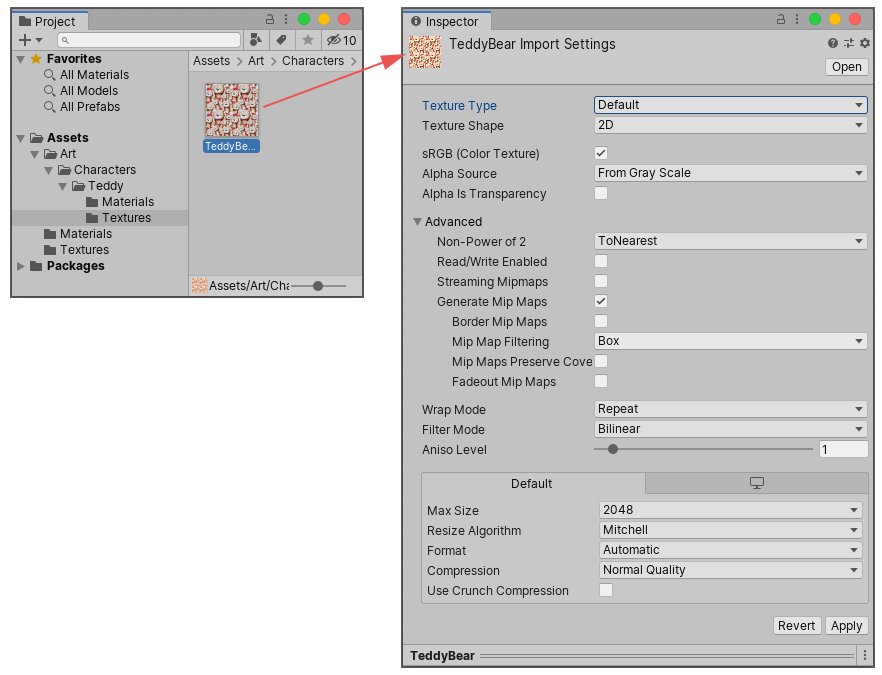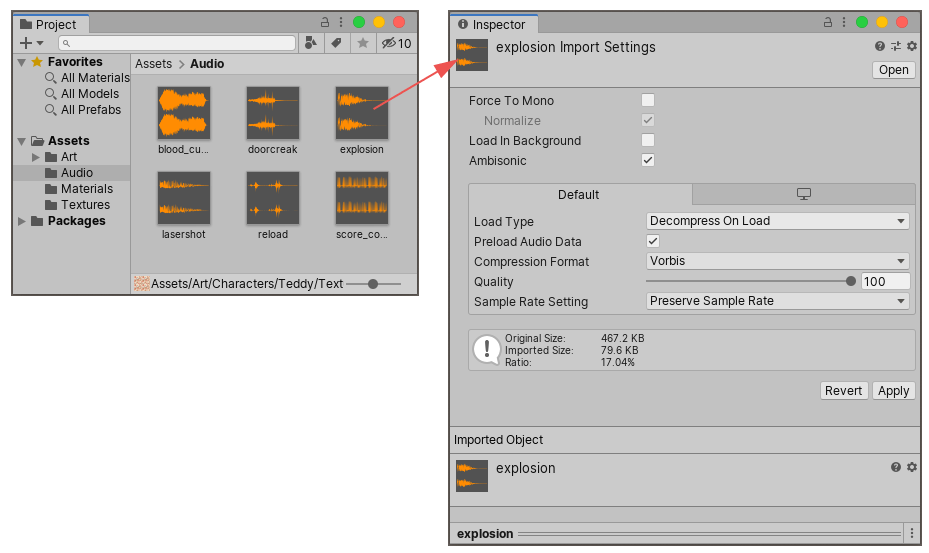Importing assets
You can bring assets created outside of Unity into your Unity project. To do this, you can either export the file directly into the Assets folder for your project, or copy it into that folder. For many common formats, you can save your source file directly into your project’s Assets folder and Unity can read it. Unity also detects when you save new changes to the file and re-imports files as necessary.
When you create a Unity project, Unity creates a folder (named after your project) which contains the following subfolders:
TempLibraryAssetsProjectSettingsLogsPackages
You can save or copy files that you want to use in your project into the Assets folder, and you can use the Project windowA window that shows the contents of your Assets folder (Project tab) More info
See in Glossary inside Unity to view the contents of your Assets folder. Therefore, if you save or copy a file to your Assets folder, Unity imports it and it then appears in your Project window.
When you modify a file in Unity, Unity does not modify your original source file, even though you can often choose between various ways to compress, modify, or otherwise process the asset within Unity. Instead, the import process reads your source file, and creates a game-ready representation of your asset internally, matching your chosen import settings. If you modify the import settings for an asset, or make a change to the source file in the Assets folder, Unity re-imports the asset again to reflect your changes.
Warning: In most cases, the items that appear in your Project window represent actual files on your computer. If you delete them within the Unity Editor Project window, you also delete them from your computer.
Unity automatically detects files as they are added to the Assets folder, or if they are modified. When you put any asset into your Assets folder, it appears in your Project window.

If you drag a file from your computer’s file browser into Unity’s Project window, Unity makes a copy and places it into your Assets folder. You can then access this copy from the Project window.
To bring collections of assets into your project from another Unity project, you can use Asset packagesA collection of files and data from Unity projects, or elements of projects, which are compressed and stored in one file, similar to Zip files, with the .unitypackage extension. Asset packages are a handy way of sharing and re-using Unity projects and collections of assets. More info
See in Glossary.
Asset Import Settings
The simplest way to safely move or rename your assets is to always do it from within Unity’s project folder. This way, Unity automatically moves or renames the corresponding meta file. To read more about .meta files and the import process, see How Unity imports assets.
Each type of asset that Unity supports has a set of Import Settings, which affect how the asset appears or behaves. To view an asset’s import settings, select the asset in the Project View. The import settings for this asset will appear in the InspectorA Unity window that displays information about the currently selected GameObject, asset or project settings, allowing you to inspect and edit the values. More info
See in Glossary. The options that appear vary depending on the type of asset selected.
For example, an image’s import settings allow you to choose whether Unity imports it as a Texture, a 2D spriteA 2D graphic objects. If you are used to working in 3D, Sprites are essentially just standard textures but there are special techniques for combining and managing sprite textures for efficiency and convenience during development. More info
See in Glossary, or a normal mapA type of Bump Map texture that allows you to add surface detail such as bumps, grooves, and scratches to a model which catch the light as if they are represented by real geometry.
See in Glossary. The import settings for an FBX file allow you to adjust the scale, generate normals or lightmapA pre-rendered texture that contains the effects of light sources on static objects in the scene. Lightmaps are overlaid on top of scene geometry to create the effect of lighting. More info
See in Glossary coordinates, and split & trim animation clipsAnimation data that can be used for animated characters or simple animations. It is a simple “unit” piece of motion, such as (one specific instance of) “Idle”, “Walk” or “Run”. More info
See in Glossary defined in the file.

For other asset types, the import settings look different. The various settings you see relate to the type of asset selected. Here’s an example of an Audio asset, with its related import settings shown in the inspector:

If you are developing a cross-platform project, you can override the “default” settings and assign different import settings on a per-platform basis.
Asset processing
Unity reads and processes any files that you add to the Assets folder, and converts the contents of the file to internal game-ready data. The asset files themselves remain unchanged, and the internal data is stored in the project’s Library folder. This data is part of the Unity Editor’s Asset Database.
Using internal formats for assets allows Unity to have internal versions of your assets ready to use at runtime in the Editor, and to keep your unmodified source files in the Assets folder. A distinction between the asset files and the internal versions means that you can quickly edit the asset file, and have the Editor pick up the changes automatically. For example, you can save .psd files directly into your Assets folder, but hardware such as mobile devices and PC graphics cards can’t process that format directly in order to render them as textures. Instead, Unity can convert an internal version into a format that those platforms can process.
Unity stores the internal representation of your assets in the Library folder, which behaves like a cache folder. As a user, you should never need to alter the Library folder manually; if you do, you might negatively affect your project in the Unity Editor. This also means that you should not include the Library folder under version controlA system for managing file changes. You can use Unity in conjunction with most common version control tools, including Perforce, Git, Mercurial and PlasticSCM. More info
See in Glossary.
Note: If your project is not open in Unity, you can safely delete the Library folder, because Unity can regenerate all of its data from the Assets and ProjectSettings folders the next time you launch your project.
Complex assets
In some cases, Unity might create multiple assets while importing a single asset file. For example:
- When a 3D file (such as an FBX file) defines Materials or contains embedded Textures. To handle this, Unity extracts the Materials and embedded Textures as separate assets.
- When you want to import an image file as multiple 2D sprites. You should use the 2D Sprite Editor to define multiple sprites from a single graphic image. Unity displays each sprite defined in the Editor as a separate Sprite asset in the Project window.
- When a 3D file contains multiple animation timelines or multiple clips. To handle this, Unity automatically defines separate animation timelines or clips based on its animation import settings. The resulting multiple animation clips appear as separate Animation Clip assets in the Project window.
See also
- Asset packages
- Materials and Shaders
- Textures and Videos
- Sprite Editor
- Sprite AtlasA utility that packs several sprite textures tightly together within a single texture known as an atlas. More info
See in Glossary - Audio Files
- Tracker Modules